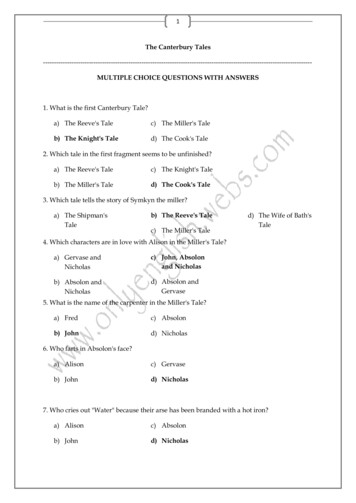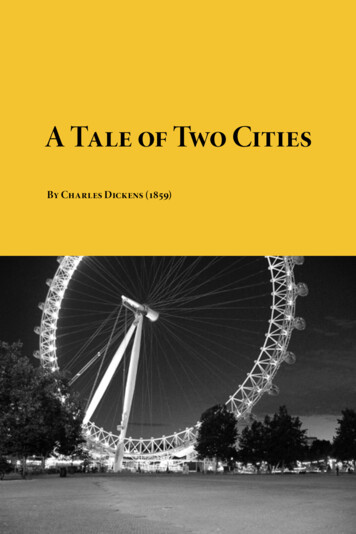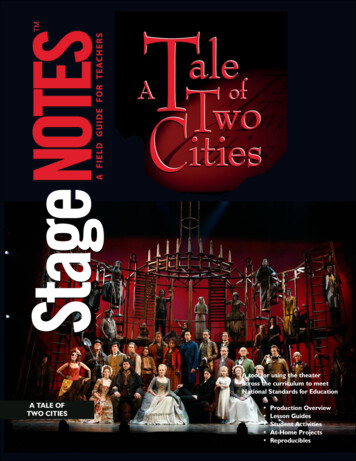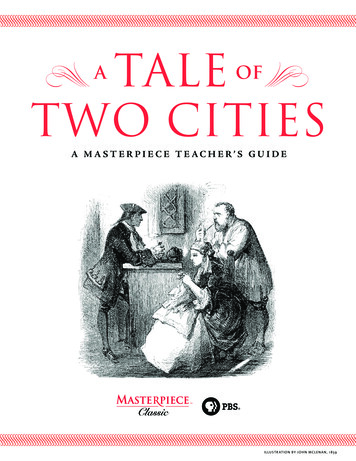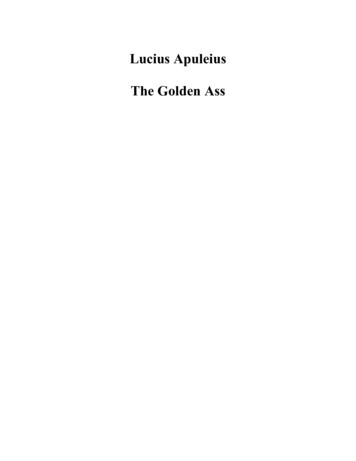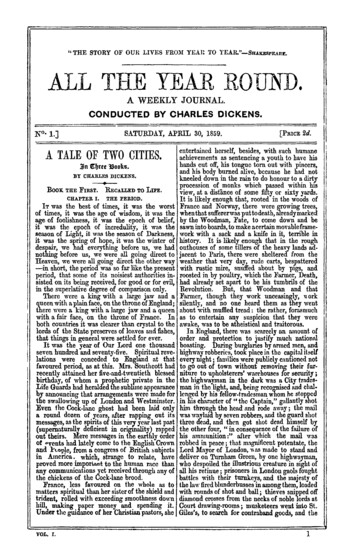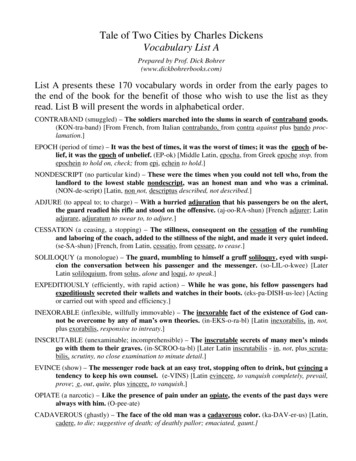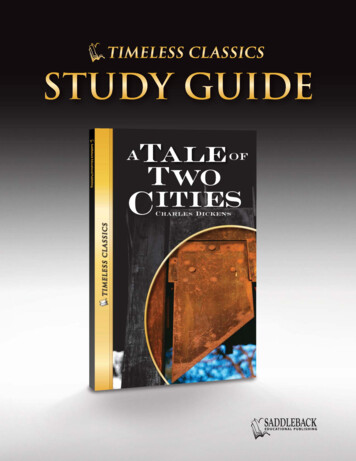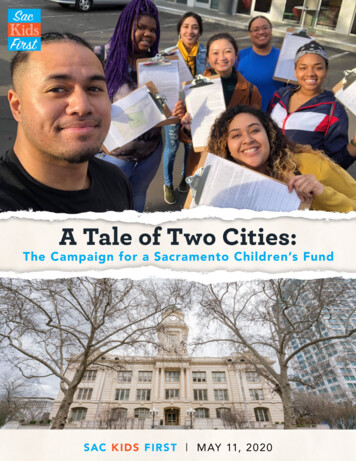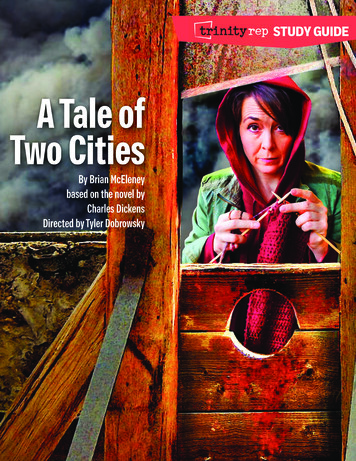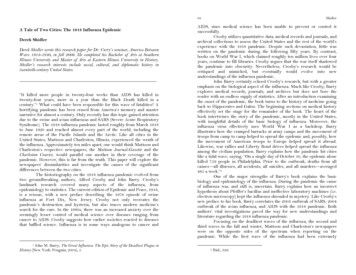
Transcription
88A Tale of Two Cities: The 1918 Influenza EpidemicDerek ShidlerDerek Shidler wrote this research paper for Dr. Curry’s seminar, America BetweenWars: 1918-1940, in fall 2009. He completed his Bachelor of Arts at SouthernIllinois University and Master of Arts at Eastern Illinois University in History.Shidler’s research interests include social, cultural, and diplomatic history intwentieth-century United States.“It killed more people in twenty-four weeks than AIDS has killed intwenty-four years, more in a year than the Black Death killed in acentury.”1 What could have been responsible for this wave of fatalities? Ahorrifying pandemic has been erased from America’s memory and masternarrative for almost a century. Only recently has this topic gained attentiondue to the swine and avian influenzas and SARS (Severe Acute RespiratorySyndrome). The 1918 influenza pandemic lasted roughly from March 1918to June 1920 and reached almost every part of the world, including theremote areas of the Pacific Islands and the Arctic. Like all cities in theUnited States, Mattoon and Charleston, Illinois, experienced the wrath ofthe influenza. Approximately ten miles apart, one would think Mattoon andCharleston’s respective newspapers, the Mattoon Journal-Gazette and theCharleston Courier, would parallel one another in their coverage of thepandemic. However, this is far from the truth. This paper will explore thenewspapers’ dissimilarities and investigate the causes of the significantdifferences between the two cities.The historiography on the 1918 influenza pandemic evolved fromtwo groundbreaking authors, Alfred Crosby and John Barry. Crosby’slandmark research covered many aspects of the influenza, fromepidemiology to statistics. The current edition of Epidemic and Peace, 1918,is a reissue, with a new preface describing the 1976 episode of swineinfluenza at Fort Dix, New Jersey. Crosby not only recreates thepandemic’s destruction and hysteria, but also traces modern medicine’ssearch for the cure. In the 1980s, there was an increased anxiety over theseemingly lesser control of medical science over diseases ranging fromcancer to AIDS. Crosby suggests how earlier societies reacted to diseasesthat baffled science. Influenza is in some ways analogous to cancer and1 John M. Barry, The Great Influenza: The Epic Story of the Deadliest Plague inHistory (New York: Penguin, 2004), 5.ShidlerAIDS, since medical science has been unable to prevent or control itsuccessfully.Crosby utilizes quantitative data, medical records and journals, andarchival collections to assess the United States and the rest of the world’sexperience with the 1918 pandemic. Despite such devastation, little waswritten on the pandemic during the following fifty years. By contrast,books on World War I, which claimed roughly ten million lives over fouryears, continue to fill libraries. Crosby argues that the war itself shadowedthe pandemic into obscurity. Nevertheless, Crosby’s research would becritiqued and mimicked, but eventually would evolve into newunderstandings of the influenza pandemic.John Barry certainly echoed Crosby’s research, but with a greateremphasis on the biological aspect of the influenza. Much like Crosby, Barryexplores medical records, journals, and archives but does not bore thereader with an endless supply of statistics. After an introduction examiningthe onset of the pandemic, the book turns to the history of medicine goingback to Hippocrates and Galen. The beginning sections on medical historyeffectively set the stage for the remainder of the book. The heart of thebook intertwines the story of the pandemic, mostly in the United States,with insightful details of the basic biology of influenza. Moreover, theinfluenza virus effectively uses World War I as a backdrop. Barryillustrates how the cramped barracks at army camps and the movement oftroops from camp to camp helped to spread the epidemic and, possibly, howthe movement of American troops to Europe helped spread it abroad.Likewise, war rallies and Liberty Bond drives helped spread the influenzaamong the civilian population. Barry explains how the pandemic hit citieslike a tidal wave, saying, “On a single day of October 10, the epidemic alonekilled 759 people in Philadelphia. Prior to the outbreak, deaths from allcauses—all illnesses, all accidents, all suicides, and all murders—averaged485 a week.”2One of the major strengths of Barry’s book explains the basicbiology and epidemiology of the influenza. During the pandemic the causeof influenza was, and still is, uncertain. Barry explains how an incorrecthypothesis about Pfeiffer’s bacillus and ineffective laboratory machines (i.e.electron microscopy) kept the influenza shrouded in mystery. Like Crosby’snew preface to his book, Barry correlates the 2003 outbreak of SARS, 2004outbreak of the avian influenza, and AIDS with the 1918 pandemic. Bothauthors’ vital investigations paved the way for new understandings andliterature regarding the 1918 influenza pandemic.Focusing on the deadliest waves of the influenza, the second andthird waves in the fall and winter, Mattoon and Charleston’s newspaperswere on the opposite sides of the spectrum when reporting on thepandemic. While the first wave of the influenza had been extremely2Ibid., 329.
Historia 201089contagious, the second and third waves were both contagious andexceedingly deadly, which I will focus on in this paper. Beginning in theNew England states, hospital infirmaries became overcrowded with the sickand dying, and the disease eventually reached rural areas of Illinois. ByOctober, the Mattoon Journal-Gazette began reporting closings of schools,churches, movie theaters, and Red Cross meetings. “’Flu’ Stops Meeting”made the front-page news in the Gazette. Dr. C. St. Clair Drake, medicaldirector of Illinois, and Governor Frank O. Lowden shut down all politicalassemblages since overcrowding helped spread the influenza.3The Mattoon Journal-Gazette’s obituary section ultimately becameoverwhelmed with civilian and troop deaths due to the influenza. Theeditorial, “With the Sick,” sprang up in late October focusing on the sick,dead, and business closings. In the October 17, 1918 issue, Miss FloraBowman, Mattoon’s school and community nurse, suffered from a nervousbreakdown due to overworking since the community was suffering from theinfluenza, while a Windsor mail carrier, Oran Perry Cox, died in his homedue to the virus.4 This same newspaper reported the deaths of Mr. and Mrs.Miller and Mrs. Maud Jay, all victims of the pandemic.5 Eight days later, aheadline stated “Influenza Takes Well Known Men.” Mattoon lost twosignificant men—Daniel B. Rinehart, court stenographer, and his brother,Walter E. Rinehart, an attorney.6 The citizens of Mattoon were well awareof the shocking situations, and certainly portrayed it in their newspaper.Moreover, the Gazette published an article explaining the demanding andcontinuous problems Mattoon was facing, titled, “Two Trained Nurses ontheir Way to Mattoon.”7 Two Bloomington, Illinois, nurses were sent toMattoon “to assist the local health and Red Cross workers in caring for theinfluenza and pneumonia sufferers.”8 The hysteria over the influenza beganreaching critical conditions by late October.With the influenza in its second wave, the Gazette, on October 28,1918, printed an article hoping to pass a sanatorium law that wouldfacilitate a medical facility for the sick.9 Meanwhile, Washington “Urged toStamp Out Spanish Influenza by establishing emergency hospitals.”10Mattoon never tried to hide or dilute the seriousness of the pandemic. Asthe influenza continued to seep into the Gazette, so did Dr. Ferguson, apracticing doctor in Mattoon. On December 14, 1918, Dr. Fergusonannounced, “there are approximately twenty cases reported a day inMattoon Journal-Gazette, 18 October 1918.Ibid.5 Ibid.6 Ibid., 25 October 1918.7 Ibid., 23 October 1918.8 Ibid.9 Ibid., 28 October 1918.10 Ibid., 21 October 1918.90ShidlerMattoon,” and went on to say, “there will probably be successive waves.”11The doctor had good reason for his anxiety. Influenza casualtiesoutnumbered all other deaths, however, subsequent waves never devastatedMattoon as predicted. Nevertheless, with the holiday season quicklyapproaching, the Gazette noted, “stores will stay open later to avoidcongestion on Christmas Eve shoppers.”12 The influenza pandemic clearlyaffected the citizens of Mattoon and reconfigured the way in which theylived, but that was only the beginning.The most significant difference between the two newspapers,Charleston Courier and Mattoon Journal-Gazette, were the remedies theypublicized. Local businesses began buying up sections in the Gazette inorder to advertise their elixirs, pills, and ointments. A special honey elixir,by Dr. Baker of Mattoon, claimed to prevent the “flu” from affecting anyonewho took this concoction.13 Dr. Frankein Duane offered his professionaladvice saying, “The more you fear the disease, the surer you are to get it.”14With such reassurance, readers awaited Dr. Duane’s sincere guidance.However, the doctor’s long five paragraphs was only a sales pitch for hisproduct. “Thoroughly loosen the bowels with some such mild and nonirritating physic as Dr. Pierce’s Pleasant Pellets,” Dr. Duane wrote.15 Butwhat if a person was already severely weakened by the influenza? Well thedoctor had another remedy, “Irontic.” The ad claimed that this herbal tonichad been used by thousands, and would certainly provide a fighting edgeagainst the pandemic, so it says. In a related article, on November 1, 1918,Dr. L. W. Bowers also advertised how Dr. Pierce’s Pleasant Pellets would“keep the liver and bowels regular and to carry away the poisons within.”16A plethora of Dr. Pierce’s herbal remedies are found throughout theGazette, and this was only one of many.“Look out for the Spanish Influenza,” a patent medicineadvertisement, Cascara Quinine, states.17 This supposed influenza remedyadvertisement was plastered across the pages of nearly every issue of theMattoon Journal-Gazette. In addition, other medicines that began springingup in the Gazette were Vick’s VapoRub, Dr. Bell’s Pine Tar Honey,Schenck’s Mandrake Pills, Beecham’s Pills, and, one of the more exoticproducts, Miller’s Antiseptic Snake Oil. Page after page, day after day, theGazette was flooded with influenza remedies. These remedy advertisementsare one of the elements unique to the Gazette. Unlike the Mattoon JournalGazette, the Charleston Courier seldom published influenza remedy ads.Stuart’s Drug Store advertisements were only one of about two remedies34Ibid., 14 December 1918.Ibid., 18 December 1918.13 Ibid., 17 December 1918, p. 3.14 Ibid., 8 November 1918.15 Ibid.16 Ibid., 1 November 1918.17 Ibid., 28 October 1918.1112
Historia 201091found in the Charleston Courier. Unlike snake oil, pine tar honey, and pills,Stuart offered a nose and throat spray—interestingly traditional comparedto the bizarre concoctions found in the Gazette.The most intriguing influenza remedy was Vick’s VapoRub.Claiming, “When VapoRub is applied over throat and chest the medicatedvapors loosen the phlegm, open the air passages and stimulates the mucusmembrane to throw off the germs,” was an impressive scientific approach tocuring the virus.18 However, Vick’s VapoRub did not stop there. This piecewas dissected into several topics. First was the history behind the “SpanishInfluenza,” while the subsequent topics explored the symptoms, treatment,external applications, how to avoid the disease, and where Vick’s VapoRubwas founded. This advertisement was so influential that days later headlineserupted saying, “Druggists! Please Note Vick’s VapoRub Oversold Due toPresent Epidemic,” and went on to say, “Tremendous demand last few dayshas wiped out excess stocks that we had estimated would last until3nextJanuary.19 Last week’s orders called for one and three quarter million jars—today’s orders alone amount to 932,459 jars.”20 In this lengthyadvertisement, Vick’s VapoRub explains the dangers of shortage if suppliesare not conserved and properly distributed, while new ways to useVapoRub were also mentioned in the advertisement. On November 8, 1918,Vick’s VapoRub offered another plea, saying, “Druggists Still Asked toConserve Stocks of VapoRub Needed in ‘Flu’ Districts.”21 Once again, theadvertisement explains the origins of the “flu,” but also provides moreinformation on how VapoRub works.The Gazette’s comic strips even began poking fun at the influenza.“Doings of the Duffs” depicts Tom, the main character, waiting to step intoa telephone booth. Meanwhile, a large man steps out of the booth and “KACHOO,” Tom gets sneezed on. The last frame reveals Tom standing in thebooth wiping his nose, saying, “And in flew enza!”(Figure 1).22 On October31, 1918, “Doings of the Duffs” poked fun at the influenza once more.However, this time Tom’s baby yanks on a tablecloth and releases a cloudof pepper. Tom, his wife, and baby begin sneezing uncontrollably. The lastframe shows Tom on the phone saying, “Oh, Doc. Come right over—we’veall got it!”(Figure 2).23The Mattoon Journal-Gazette certainly did not hide the influenza’sdevastating path. Headlines like “Influenza Cause of 18,000 deaths” and“Flu Toll is 22,563 in State” were found throughout the newspaper in1918.24 Besides the press publicizing the influenza’s wrath, the GazetteIbid., 18 October 1918.Ibid., 21 October 1918.20 Ibid.21 Ibid., 8 November 1918.22 Ibid., 24 October 1918.23 Ibid., 31 October 1918.24 Ibid., 9 November 1918 and 30 November 191892Shidleradvertised unique remedies. Elixirs, pills, and ointments flooded Mattoon’snewspaper from late 1918 to early 1919. In addition, although lighthearted, the comic strips depicted the influenza in a comedic way. This isquite unique since the Charleston Courier rarely commented on the influenzaand seldom advertised remedies.Although World War I and post-war reconstruction dominatednewspaper headlines, the Gazette and Courier continued to publish articlesregarding the influenza. With only ten miles between the two towns, theirnewspapers differed significantly. Although the Courier published severalarticles pertaining to the virus, it could not come close to the level of alarmreached by the Gazette. Mattoon’s newspaper published numerous articlesfocusing on local people and businesses that were affected by the pandemic.However, Charleston’s newspaper covered issues concerning Chicago andthe larger cities in the United States. For example, on November 27, 1918,the Courier stated, “Flu Never Closed New York Schools.”25 There was evenan article that talked about an influenza serum for Chicagoans. On rareoccasions, the Courier would mention the growing problem with headlinessuch as “22,566 Deaths from Influenza.”26 This was certainly a rarity. Mostheadlines read, “Influenza Situation Greatly Improved” and “No NewOutbreak of Influenza.”27 The Courier seemed to leave the influenza by thewayside. Other articles such as, “Della Ashmore Had No Fear of Influenza”and “Oldest Influenza Victim Recovering” revealed Charleston’s amount ofconcern—slim to none.28When the Courier did focus on the influenza, the newspaper took ascientific approach. The superintendent of the Public Health NursingAssociation stated that spitting is a “filthy, dangerous, and unnecessaryhabit,” and went on to say, “Terre Haute is most decidedly leading in thiscampaign to prevent the spread of this disease.”29 Meanwhile, the Courierpublished an article focusing on Cleveland, Ohio, saying, “It is a knownfault of men that they like to spit into dark corners the General ElectricCompany, in promoting an anti-spitting campaign in an effort to check theinfluenza, has hit upon a scheme that is said to be working extremely wellin checking spitting in corners.”30 On November 20, 1918, also focusing onOhio, the Courier looked for scientific answers to solve the pandemic crisisby explaining that the spread of the influenza was due to the chillyconditions in homes and offices. As the differences between the newspaperscontinued to grow, the Courier published a section called “The OldRounder” which contained jokes and poems regarding the virus. In theOctober 10, 1918 issue, the Courier joked about the pandemic, saying, “Why1819Charleston Courier 27 November 1918.Ibid., 3 November 1918.27 Ibid., 16 October 1918 and 22 December 4 1918.28 Ibid., 21 November 1918 and 30 October 1918.29 Ibid., 16 October 1918.30 Ibid., 20 November 1918.2526
Historia 201093is the city library closed? Because they found influenza in the dictionary.”31The Courier seemed annoyed by all the hype the influenza produced. Thiscan be seen in the October 21, 1918 edition, from an anonymous manportraying his feelings, saying:Last night as I lay trying to go to sleep the words “SpanishFlu” drifted up to my ear from the conversation of passerby.And the last I remembered was my mind was working doubleshifts on Spanish Flu. This morning I woke up an hour late,and my first thought was “I wonder if that’s a symptom ofSpanish Flu. The toothpaste didn’t taste right—Spanish Flu.The bath soap burned my eyes—Spanish Flu. My beardseemed to have grown pretty fast and tough overnight—Spanish Flu. Breakfast didn’t seem to have its regular taste—Spanish Flu. On the way to work I heard coughs and sneezesof other people—Spanish Flu. I felt like coughing andsneezing—Spanish Flu. All day at work I thought—SpanishFlu—and here I finish the day with type chirping aboutSpanish Flu!32Unlike the Gazette, the Courier seldom published influenza remedies.While the Mattoon Journal-Gazette sold snake oil, Vick’s VapoRub, pine tarhoney, and pills, the Charleston Courier offered few remedies—not thebizarre concoctions found in the Gazette. However, both newspapersshowed high number of flu-related deaths in their obituaries. Besides newspertaining to the war and post-war reconstruction, these two newspaperswere considerably different from one another. While the Gazette focused onlocal influenza issues, the Courier focused on Chicago and other larger cities’influenza problems. When the Gazette published comic strips, the Couriertook a scientific approach to solve the influenza troubles. Most people,including local historians, agree that the difference lies in class conflict—Mattoon is blue-collar while Charleston is a white-collar city. So why arethese two towns, which are a mere ten miles apart, so different? Archivalresearch significantly points to a few key issues. First was the differencebetween the two newspapers. Secondly, the industrial rise of Mattoon andits railroads rendered it a blue-collar city. Thirdly, and most importantly,was the founding of Eastern Illinois State Normal School.Charleston’s first newspaper was established by William Harr andWilliam Workman in 1863. The Courier was later sold to Eli Chittendonwho, in 1863, changed the name to Plaindealer. After years of purchasingand name changing, Charleston, in 1880, eventually had threenewspapers—Courier, Plaindealer, and Saturday Evening Herald. In 1923,3132Ibid., 10 October 1918.Ibid., 21 October 1918.94ShidlerJames K. Rardin, an Irish pioneer and founder of the Saturday EveningHerald, merged his newspaper company with the Plaindealer, makingPlaindealer-Herald. The Rardins, the new owners of the newspaper, wereearly Charleston settlers, who were opinionated and ambitious Democrats.After several more years of merging, purchasing, and name changing,Charleston had one Democratic newspaper, the Charleston-Courier.33Contradictory to Charleston, Mattoon’s newspapers stood on theopposite side of the political spectrum. On June 7, 1856, a pioneer citizen,R.W. Houghton, started printing the Weekly Independent Gazette—a fourpage publication.34 Like Charleston, Mattoon saw its fair share ofnewspaper changes—Weekly Independent Gazette (1856), Mattoon DailyJournal (1865), Radical Republican (1867), Mattoon Commercial (1871),Mattoon Morning Star (1888), and Mattoon Journal-Gazette (1905).35However, Mattoon catered toward a republican readership—obviously witha newspaper called Radical Republican. But why were these two newspaperscatering to two different crowds? First, Charleston’s newspapers weremostly owned by Democrats, while Mattoon were Republicans. Secondly,there was a blue-collar versus white-collar separation between the twocities. Mattoon’s industrial roots began with water in 1865. H.W. Clarkfounded the first privately owned water system, thus creating the firstindustry in Mattoon.36 Industries seemed to flourish after 1865, andbrought not only money to the community but also fame. Such was the caseof the Chuse Engine and Manufacturing Company. The company’s claim tofame came in 1894 when Chuse agreed to build a high-speed steam engine,using electrical generators, for the Somerville & Merks electric lightplant.37 Since 1855, Mattoon was also “a railroad town.”38 Life revolvedaround the rail yards. Hotels and restaurants were built closely toMattoon’s railroads, while the rail yard employed hundreds of workers. Asa result, Mattoon’s industrial blue-collar society favored Republican views,thus paving a way for Republican oriented newspapers.While Mattoon began taking shape as an industrial city, Charlestontransformed from a farm community to a white-collar teacher-producingcity. Certainly the major rift between the two cities was the bid for a statenormal school in eastern Illinois. In 1857, the first state normal school wasestablished in Bloomington that became Illinois State Normal University.The second was established in Carbondale in 1869, which became Southern33 Coles County Illinois 1876-1976: The Charleston and Mattoon Bicentennial(Texas: Taylor Publishing Company, 1976), 254-255.34 Mattoon Memories: Mattoon Centennial, 1855-1955. Unknown author andpublisher. Circa 1955. Found at Coles County Historical Society.35 Ibid.36 Coles County Illinois 1876-1976: The Charleston and Mattoon Bicentennial(Texas: Taylor Publishing Company, 1976), 356-357.37 Ibid.38 Coles County Illinois 1876-1976, 356.
Historia 201095Illinois Normal College. A committee report regarding the Illinois Senatein 1887 recognized the value of state normal schools and the state’sobligation to support them in order to meet the demand for qualifiedteachers. School officials and teachers claimed that two normal schools wereinsufficient to meet the critical need for qualified teachers. In December1892, the Illinois State Teachers’ Association meeting in Springfieldacknowledged a need for more normal schools, thus creating a normalschool committee of seven. The following year some of these membersexpressed the opinion, at a state meeting, that Illinois would benefit fromthe establishment of three to five more normal schools within the state.39A few months later, a movement for establishing a state normalschool in eastern Illinois began. Mattoon, Charleston, Paris, Danville,Shelbyville, Effingham, Kansas, Olney, Oakland, Palestine, Lawrenceville,and Tuscola all strived for future economic and cultural opportunities thataccompany a state normal school. Mattoon had every reason to believe thatit would become the seat of the normal school, instead of its nearestopponent, Charleston. Since Mattoon had a population of approximately9,622 (compared to Charleston’s 5,488), rail lines running both north andsouth and east and west (while Charleston’s only ran east and west), andthriving industries, Mattoon was clearly the best city for a state normalschool.40 Mattoon was so confident it would receive the normal school thatthe Mattoon Journal-Gazette claimed, “there is every opportunity ofwinning.”41Charleston stepped up to the plate by presenting a comprehensiveproposal to the board of trustees. If Charleston established the normalschool within two miles of the Coles County courthouse in Charleston, thecity would provide forty acres of land and roughly 40,000 to the school.The city would also run water lines to the site, provide fire hydrants, andsupply the school with water for fifty years at 5.00 a year. In addition, thecity would pave or gravel a street from the courthouse to the edge ofcampus and provide sidewalks, furnish incandescent lights for twenty-fiveyears at the rate of ten cents per thousand watts, and provide up to 5,000worth of freight to the school on any of the rail lines of the Cleveland,Cincinnati, Chicago, & St. Louis Railroad Company.42 This offer surpassed39 Smith and W.E.C. Clifford, Senate Committee Report on the Normal CollegesState of Illinois (Dekalb: Industrial Arts Press, Industrial Arts Department, NorthernIllinois State Teachers College, 1936), 12.40 The population of Mattoon in 1890 was 6,833 and Charleston, 4,135(Twelfth Census of the United States, Taken in the Year 1900: Population[Washington, D.C.: United States Census Office, 1901]), 116.41 Mattoon Journal-Gazette, 8 February 1895.42 R.S. Hodgen, Geo. R. Chambers, and Isaiah H. Johnson, “To the Board ofTrustees of the Eastern Illinois State Normal School,” University Archives, BoothLibrary.96Shidlerall other bids, and on September 7, 1895, Charleston was selected to receivethe normal school—Eastern Illinois State Normal School.The citizens of Charleston received the news in a telegram fromGeorge Jeffries, who lobbied at the statehouse in Springfield, saying, “Tothe People of Charleston: Charleston wins on the twelfth ballot. Hardfought battle. Be home tonight.”43 Obviously the citizens of Charlestonrejoiced after receiving the news. However, the reaction in Mattoon wasquite different. Eight days after Charleston was chosen to be the site for thenormal school, the Mattoon Journal-Gazette proclaimed, “Charleston Gets It.The New Reform School Located at Catfishville.” According to theCharleston Courier, Mattoon was anticipating a joyful celebration, but wasquickly stunned. “[Mattoon’s] newspapers had it all written up for theoccasion, with spread eagles, roosters, and flags lavishingly displayed, greatheadlines heralding the many qualities of the coming [new] Chicago.”Instead, “they had better been engaged in making a monster coffin in whichto bury their wrath.” According to the Gazette, the announcement thatCharleston won the bid for the school “caused more real, genuine, heartfeltprofanity” in Mattoon than any previous incident in the city’s history. “Suchwas the ending of a once beautiful dream—a dream which had pictured ourstreets filled with ten thousand sunny-faced, neatly-dressed, happy-heartedsons, daughters and Charlestoners on their way to learn to beteachers!.The question of the Eastern Illinois normal originated in thiscity, its citizens fought the opposition to a successful termination and thelaw creating it was passed; in all decency it should have been ours.”44In the wake of Mattoon’s frustration, allegations began circulatingregarding bribery. The disgruntled citizens of Mattoon were certain thatthe trustees had received money from Charleston.45 The Mattoon JournalGazette pressed this issue, reporting that the people of Charleston openlybragged about “the purchase of the trustees.”46 Seven days later, thenewspaper stated that “every man, woman and child in Charleston has beentaught to believe that the trustees were bought up body and soul and havetalked openly on the streets to that effect.”47 Countering these rumors, theCharleston Courier believed the bribery accusation was a personal insult toCharleston, saying C.G. Peck, editor of the Gazette, was “a dirty cur.”48Losing the bid to Charleston certainly irritated the citizens of Mattoon,declaring, “every brick going into that edifice will be considered markedwith boodle and every drop of mortar with which they are cemented with431895.George H. Jeffries, Telegram, “To the People of Charleston,” 7 SeptemberMattoon Journal-Gazette, 13 September 1895.Charleston Courier, 12 September 1895.46 Mattoon Journal-Gazette, 13 September 1895.47 Ibid., 20 September 1895.48 Charleston Courier, 12 September 1895.4445
Historia 201097fraud.”49 The Charleston-Mattoon rivalry began well before the bid for anormal school and would continue for other reasons, as local rivalries do.Nevertheless, the fact that Mattoon spearheaded the movement for anormal school in Coles County, only to have it taken away by Charleston,ensured that their rivalry would continue.It should be noted that the Mattoon Journal-Gazette has a history ofreporting on local hysteria. In 1944, the best known case of mass hysteriawas the “Mad Gasser” of Mattoon. Known as the Anesthetic Prowler, MadAnesthetist, and, eventually, Mad Gasser, several local families reportedbeing attacked by an unidentified person. This inevitably created panicthroughout the small town. Rumors began circulating, from Nazis invadingMattoon to a high school chemistry student playing a prank. However, ifNazis invading Mattoon was not absurd enough, a Mattoon fortuneteller,Edna James, began circulating claims that the Mad Gasser was actually an“ape man.” Nevertheless, State Attorney William E. Kidwell, branded thehysteria as “ridiculous” and said that the police let the situation needlesslyescalate out of control.50 Meanwhile, the State Police Captain, Harry Curtis,believed most reported gassings were false alarms.51 Within a few weeks,gassing reports stopped, but not Mattoon’s newly founded fame. TheDecatur Herald made fun of the imaginative Mattoonites, saying, “At thisseason of the year odors are sniffed not merely by individuals but by entirecommunities. Our neighbors in Mattoon sniffed their town into newspaperheadlines from coast to coast.”52 Consequently, all mad gasser reportsstopped, but Mattoon’s image of being a backward town was ingrained inthe minds of Americans everywhere. Mentioning this incident certainlyhelps prove the differences between Mattoon and Charleston’s newspapers.Like the gasser, the influenza created a mass hysteria, and rightfully so,while Charleston was aware of but calm about the
A Tale of Two Cities: The 1918 Influenza Epidemic Derek Shidler Derek Shidler wrote this research paper for Dr. Curry's seminar, America Between Wars: 1918-1940, in fall 2009. He completed his Bachelor of Arts at Southern Illinois University and Master of Arts at Eastern Illinois University in History.

